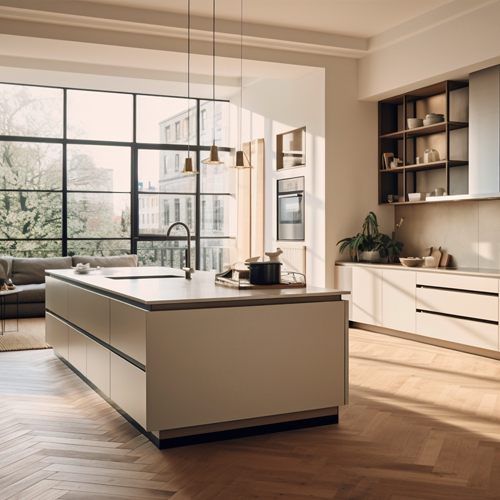Cultivating a Greener Kitchen: A Guide to Sustainable Design
The kitchen is the heart of the home, where meals are prepared, memories are made, and countless conversations unfold. But did you know that your kitchen can also be a beacon of sustainability? By incorporating eco-friendly practices into your kitchen design, you can reduce your environmental impact and create a space that’s not only beautiful but also kind to the planet.
This blog delves into the world of sustainable kitchen design, offering practical tips and inspiring ideas to elevate your kitchen while minimizing your environmental footprint.
Building a Sustainable Foundation:
Material Matters: The materials used in your kitchen cabinets, countertops, and flooring significantly impact its sustainability. Look for cabinets made from recycled or FSC-certified wood that comes from responsibly managed forests. Opt for countertops crafted from recycled materials like glass or concrete, or consider natural stone options like quartz or soapstone, which are highly durable and require minimal maintenance. Bamboo, a fast-growing and renewable resource, is also a great choice for countertops or flooring.
Energy Efficiency is Key: Modern appliances are significantly more energy-efficient than their older counterparts. Invest in Energy Star-rated appliances whenever possible, including refrigerators, dishwashers, ovens, and cooktops. Look for features like induction cooktops that offer faster and more efficient cooking, or consider a steam oven, which uses less energy than traditional ovens.
Harnessing the Power of Nature: Natural light is not only beautiful and uplifting, but it also reduces the need for artificial lighting. When designing your kitchen, maximize natural light by incorporating large windows, skylights, or solar tubes. Strategically place task lighting over work areas to ensure proper illumination without overdoing it.
Smart Design for a Sustainable Kitchen:
Water Conservation: Every drop counts! Install low-flow faucets and showerheads in your kitchen sink to significantly reduce water usage. Consider a water-efficient dishwasher that uses less water per cycle. Opt for a double sink if your budget allows, allowing you to efficiently wash dishes without constantly running water.
Waste Not, Want Not: Composting food scraps is a fantastic way to reduce waste and create nutrient-rich soil for your garden. Invest in a countertop compost bin or a dedicated under-sink composting system for easy food scrap disposal. Utilize recycling bins for paper, plastic, and glass to ensure proper waste management.
Smart Storage Solutions: A well-organized kitchen minimizes food waste and promotes efficient use of resources. Install pull-out drawers and pantry shelves that provide easy access to all your ingredients, preventing items from getting lost in the back of cabinets and spoiling. Clearly label containers for dry goods to avoid confusion and expiration.
Sustainable Features Beyond the Basics:
Embrace Secondhand: Looking for unique character and eco-friendly finds? Explore vintage shops or salvage yards for pre-loved cabinets, light fixtures, or decorative elements. Giving these pieces a second life reduces your environmental impact and adds a touch of personality to your kitchen.
Embrace Energy-Efficient Ventilation: A properly functioning range hood removes cooking odors and grease from the air, improving indoor air quality. Choose a range hood with an Energy Star rating for optimal performance and lower energy consumption.
The Power of Plants: Indoor plants not only add a touch of life to your kitchen but also help purify the air. Choose low-maintenance plants that thrive in bright or indirect sunlight, depending on your kitchen’s layout. Herbs planted in window boxes or pots add a touch of green and allow you to incorporate fresh ingredients into your meals.
Sustainable Kitchen Design: A Long-Term Investment
While some sustainable features may require an initial investment, they often pay off in the long run. Energy-efficient appliances translate to lower energy bills, and water-saving fixtures conserve a precious resource. Durable and eco-friendly materials require less frequent replacement, saving you money in the long term. Most importantly, a sustainable kitchen fosters a sense of environmental responsibility and sets a positive example for future generations.
Taking the First Step:
Whether you’re embarking on a complete kitchen renovation or simply looking for ways to greenify your existing space, there’s always room for improvement. Start by assessing your current kitchen and identifying areas where you can make sustainable changes. Research eco-friendly materials and appliances, and explore design strategies that maximize natural light and promote efficient resource usage.
Remember, every step towards sustainability, no matter how small, makes a difference. By embracing the principles outlined in this blog, you can cultivate a beautiful and functional kitchen that nourishes not only your family but also the planet.
For two decades, Pathways Creative has been on a mission to transform spaces and enrich lives. Since 2000, we’ve left our mark across 13 cities in Northern India, crafting environments that inspire and endure. We’re not just builders; we’re innovators who push boundaries and embrace the latest trends.



